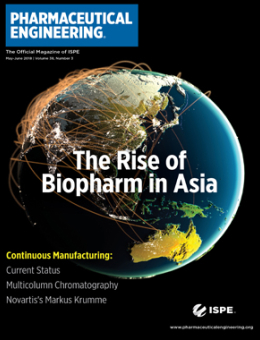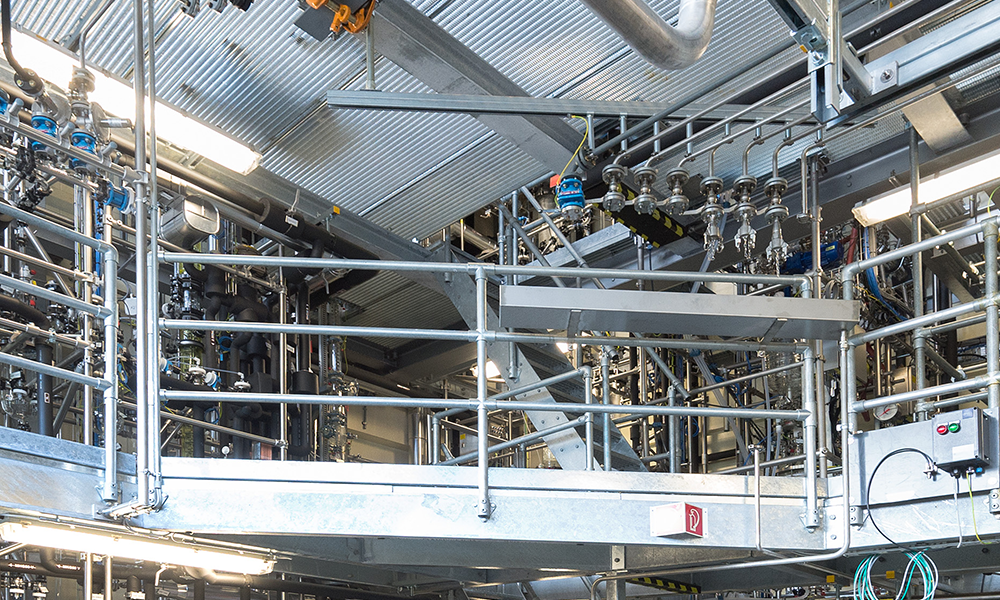"Local and regional relevance" is a key component of our strategic plan, and one that is critical to our success as an organization. It pledges us to "understand and shape strategy to the business, culture, and regulatory issues of local and regional markets." Here are a few ways in which we are doing just that:

Downloads
Biopharmaceuticals are booming in Asia, buoyed by enhanced regulations, an influx of venture capital, a culture of innovation, and government support.
The Rise of Biopharmaceutical Manufacturing in Asia
Cover: Biopharmaceuticals are booming in Asia, buoyed by enhanced regulations, an influx of venture capital, a culture of innovation, and government support. Asian pharmaceutical manufacturing has traditionally focused on generics, but things are changing.
Lego Blocks for Chemists—The Advent of Continuous Manufacturing
Feature: Spurred by pressure from governments and consumers to curb rising drug prices, pharmaceutical manufacturers are increasingly willing to look beyond traditional batch processing to cut costs and increase efficiency. Markus Krumme, Head of Continuous Manufacturing at Novartis, shares his thoughts on one of the industry’s most dramatic innovations.
Supply Chains—Dramatic Changes Ahead
Feature: Biopharmaceutical supply chains are undergoing dramatic changes. Predominant among these is the shift away from primary care to specialty products and personalized medicine, and from large-scale production of low-value small molecules to low-volume, high-value biologics. Andy Skibo, Head of Global Biologics Operations and Engineering, MedImmune/AstraZeneca, tells us why specialty product supply chains must be managed in a different way.
In This Issue
In March 2017, ISPE submitted an extensive and detailed response1
to the 2016 US Food and Drug Administration (FDA) draft guidance "Submission of Quality Metrics Data,"2
In-line concentration solves problems found in mAb production, including insufficient storage capacity and process tank volumes, extended processing times, and large hold-up loop volumes for ultrafiltration concentration. It optimizes the ion-exchange step following capture, reduces costs and processing times for virus filtration and polishing, and significantly improves the...
Biopharmaceutical supply chains are undergoing dramatic changes that will affect the design and operation of the facilities of the future. Predominant among these is the shift away from primary care to specialty products and personalized medicine, and from large-scale production of low-value small molecules to low-volume, high-value biologics.
Change in the pharmaceutical industry is notoriously slow, so it wasn't surprising that many doubted continuous manufacturing (CM) would ever be adopted. But despite the skeptics, the technology is gaining substantial ground. Since 2015, four solid oral drugs produced by continuous processes have been approved by the US Food and Drug Administration (FDA) (Table A).
Spurred by pressure from governments and consumers to curb rising drug prices, pharmaceutical manufacturers are increasingly willing to look beyond traditional batch processing to cut costs and increase efficiency. One of the industry's most dramatic innovations on this front is continuous manufacturing (CM). The technology, which produces drugs in an uninterrupted process, benefits...
ISPE's 2018 Facilities of the Future Conference highlighted emerging technologies that are driving change in pharmaceutical manufacturing. Topics included virtual reality, robotics, artificial learning, machine learning, and 3D printing. Education sessions were divided into Industry 4.0 and continuous manufacturing (CM) tracks.
Home to more than 51 million people, South Korea is one of the "Four Asian Tigers," along with Hong Kong, Singapore, and Taiwan. These countries experienced rapid expansion and high growth rates beginning in the 1960s, developing into highly advanced economies. South Korea's pharmaceutical industry is the third largest in Asia and the 13th largest in the world, with annual sales that are...
ISPE's revised IT Infrastructure Control and Compliance Guide provides comprehensive guidance on regulatory expectations for both traditional and cloud-based IT platforms. Have we done enough?
Special interest groups (SIGs) have been an important part of ISPE for many years. SIGs are formed around a specific area of interest, policy, or technology in which members have identified a common challenge. These "microcommunities" foster interaction among a variety of technical domains and often result in creative responses to industry change. SIGs must align with a community of...
Biopharmaceuticals are booming in Asia, buoyed by enhanced regulations, an influx of venture capital, a culture of innovation, and government support. Asian pharmaceutical manufacturing has traditionally focused on generics, but things are changing.1






